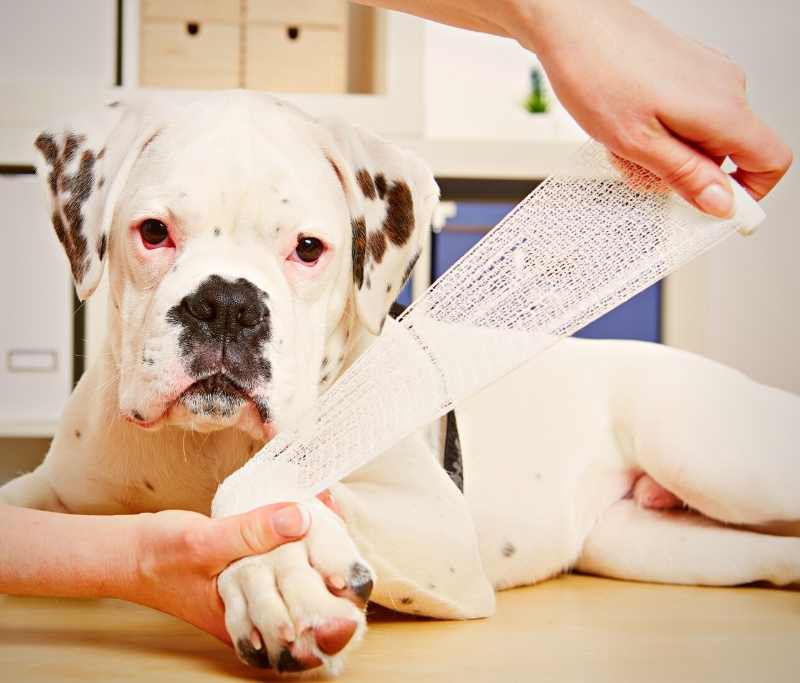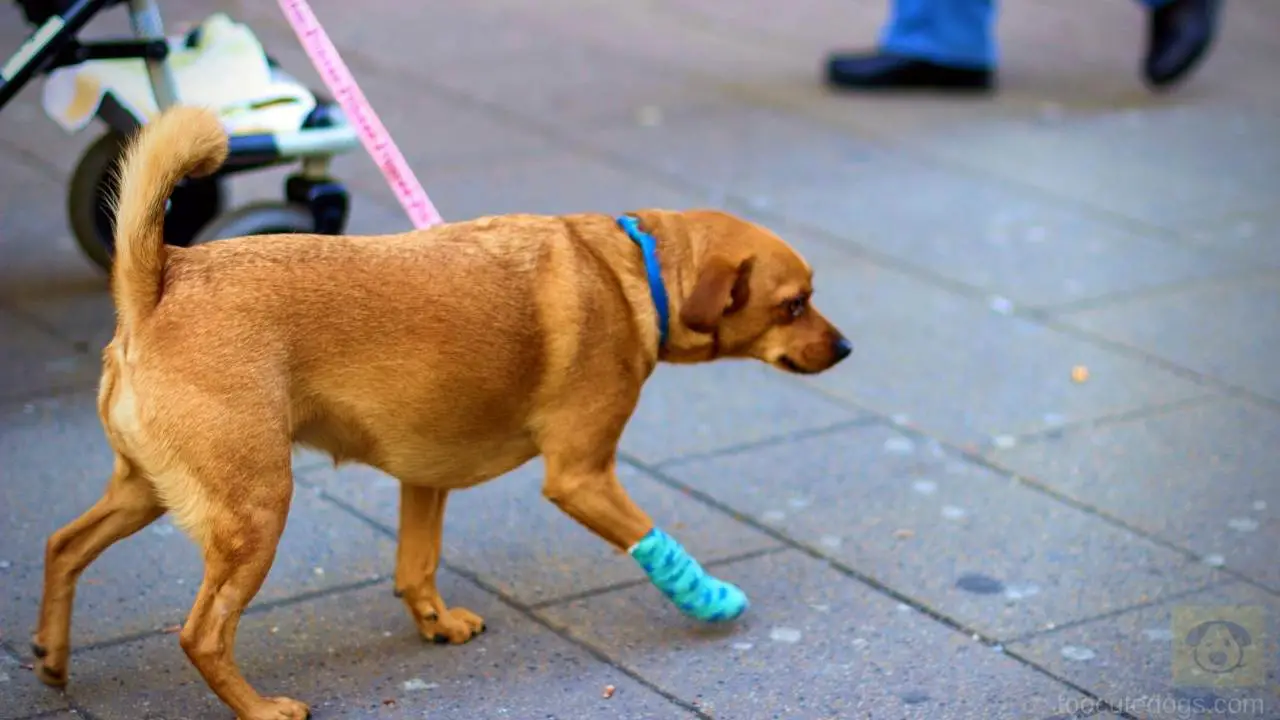Have you been wondering whether your dog has a broken leg? Some various symptoms and signs may indicate that your dog’s leg is broken.
Knowing the various symptoms to look out for, when determining whether your dog’s leg is broken is crucial because it enables you to get your dog the help they need as soon as possible. In this article, we will discuss the various possible symptoms your dog may display when they have a broken leg.
Table of Contents
Will A Dog Walk On A Broken Leg?
The severity of your dog’s broken leg will determine whether they would still be able to walk around on their broken leg. If it is not too severe, dogs will walk on a broken leg. However, if the break is severe, your dog would experience immense pain and be quite reluctant to try to walk on its broken leg.
5 Signs Of A Dog’s Broken Leg

Visible Bruising
Like us, when we have an injury, that injury may result in discoloring our skin in the form of a bruise. The affected area will quickly become purple if your dog’s fracture is severe. It may be difficult to notice the bruising on your dog because of all the fur, but if your dog displays any signs of having a broken leg, you should search for the bruises.
Swollen Leg
You should look for any swelling in your dog’s limb. Along with looking for signs of swelling, you should also note whether your dog’s leg is at an unusual angle while resting, and swelling and odd angles are clear signs of bone fracture.
Open Fracture – Visible Bone
The most notable sign of a broken bone is an open fracture. An open fracture occurs when the broken bone pierces the skin and is visible from the outside. An open fracture is particularly painful and comes with several infection risks.
Therefore, you should take your dog to the veterinarian as soon as you notice that they have an open fracture.
Howling And Whining
When dogs are in pain, they tend to communicate their pain by howling and whining. If your dog does not want to howl or whin very often for no apparent reason, you should check whether they are in pain or not. You should not ignore your dog when they start howling and moving its legs in peculiar ways.
Change In Behaviour
Often dogs tend to become edgy or aggressive when they are in pain. If your dog suddenly starts displaying this kind of behavior or suddenly isolating itself, you should check whether they are injured.
Symptoms And Diagnosis Of Broken Leg In Dogs

Symptoms
As unfortunate as it may sound, there are situations when our dogs may experience a broken leg without us knowing. In such cases, it is essential to take note of the symptoms they are displaying so that you can get your dog the help they need before they develop an infection.
These are some symptoms of a broken leg to look out for.
- Pain.
- Visible bruising.
- Whining and Howling.
- Swelling.
- Immobility/reluctance to move.
- Unusual positioning of the leg.
Sometimes, your dog’s fracture may be worse than it may appear to you. If you notice your dog displays some of the symptoms mentioned above, take them to the veterinarian. Otherwise, they may suffer from internal bleeding or some infection.
There are various types of broken bones, each of which comes with varying severity and health risks. Unbeknownst to many people, a broken bone would be life-threatening, significantly if the broken bone impacts an organ.
One of the types of broken bones is a Complete/Incomplete fracture. As the name suggests, an incomplete/complete fracture refers to the extent to which the bone has been fractured. An Incomplete fracture occurs when the fracture is partial; however, a complete fracture occurs when the fracture of the bone is fractured from one end to the other.
An Oblique, comminuted, or transverse fracture refers to how the bone was fractured. An oblique fracture is a fracture that occurs diagonally, and a comminuted fracture occurs when the bone is broken into more than three pieces. A transverse fracture occurs as a straight line through the bone.
Diagnosis
If you suspect your dog may have a broken leg, you should take them to the clinic as soon as possible. While transporting them to the clinic, you may deem it necessary to use a splint, but you should be careful and avoid trying to restore the limb’s original position as it could lead to further injury.
As soon as you reach the clinic, the clinic veterinarian will most likely try to stabilize your dog’s vitals initially. After that, the veterinarian will likely initiate an intravenous to supply your dog with antibiotics, fluids, and other forms of medication, including painkillers.
Your veterinarian may also perform some blood work if it is deemed necessary. Your dog may need to be sedated to gather radiographs of its body, and this is to understand the severity of the break better and ensure that your dog’s lungs and heart were not affected. The veterinarian team may also conduct some ultrasounds in the abdominal area as a more extensive analysis of the organs.
As another form of diagnosis, the veterinarian may insert a urinary catheter to help your dog relieve themselves and ensure that it does not put unnecessary pressure on their broken leg.
How Can I Tell If My Dogs Leg Is Broken Or Just Sprained?
Although we will discuss ways to identify whether your dog’s leg is simply sprained and not broken, you should keep in mind that none of these are conclusive. A veterinarian is qualified to diagnose your dog conclusively. If you are in doubt, instead consult a veterinarian.
These are some ways to tell if your dog’s leg is sprained and not broken.
Examine The Leg
To identify whether your dog is suffering from a sprained leg and not a bone fracture, you should examine their leg. If you cannot see a bone sticking out, you can eliminate the possibility of them sustaining an open fracture.
Determine whether their leg is at an awkward angle while they are resting. If not, then your dog may have sustained a clean break, a crack in their bone, or they may have just sprained their leg.
Allow Some Time
If your dog is not displaying any urgent signs of trauma, then give the injury some time. Wait a few days and continue to evaluate your dog’s condition. If your dog’s leg is sprained, it may not show much improvement, but the lameness should subside. If the lameness persists, you should take them to a veterinarian.
Take Note Of Your Dog’s Walk
If your dog keeps his leg in the air while he walks and is reluctant to place even a bit of pressure on it, your dog may likely suffer from a broken leg. However, this is inconclusive as some dogs walk with broken legs.
FAQ
How Does A Dog Act If Their Leg Is Broken?
A dog suffering from a broken leg will experience some behavioral changes as a result. Your once passive and friendly dog may begin to isolate itself or even develop some aggressive tendencies such as growling when they are approached.
How Do I Know If My Dogs Leg Injury Is Serious?
To know if your dog’s leg injury is severe, you should look out for the symptoms that they are displaying. If your dog avoids standing up or walking around, even when you give them treats, it may be because they simply cannot, which indicates that your dog’s injury is serious.
Will A Dog Cry If Leg Broken?
Yes, a dog will cry if they break its leg. Fracturing a leg is painful, and your dog will communicate the fact that they are in pain by howling and whining.
Should I Take My Dog To The Vet If He Is Limping?
Take your dog to the veterinarian if they’re limping. The mere fact that your dog is walking does not rule out the possibility that their leg may be broken. Some dogs walk even with a broken leg. Rather play it safe by taking your dog to the veterinarian for proper diagnosis.
Why Won’t My Dog Put Weight On Her Hind Leg?
Your dog’s hind leg could either be broken or sprained, requiring you to take them to the veterinarian. Allowing your dog to remain in such a state for too long without proper diagnosis could lead to further injuries due to the weight imbalance.
Conclusion
Various signs to look out for will help you identify whether your dog’s leg is broken. These signs include swelling, bruising, howling, and sudden behavioral changes. If you notice that your dog has a broken leg, do not dwindle; take them to the clinic as soon as possible. There are various secondary health complications that your dog may be exposed to, including infections.


